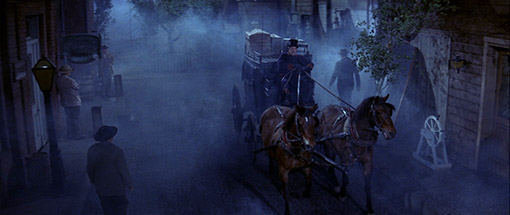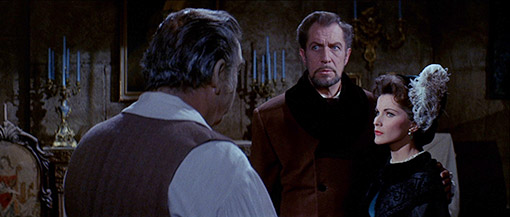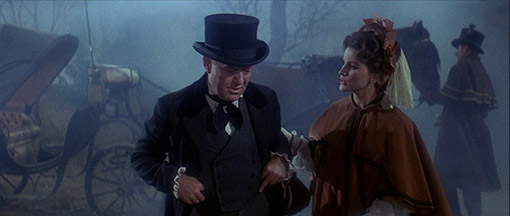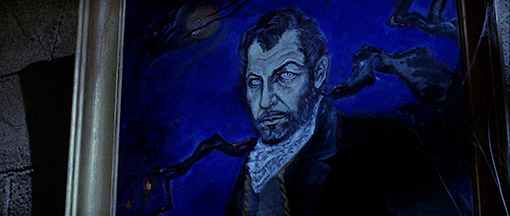|
There are a number of films in Roger Corman's Poe cycle that can lay claim to being the odd one out. Tales of Terror is a short film anthology, The Raven a comedy, The Tomb of Ligeia the film that broke out of the studio setting, and Premature Burial the only one of the series that doesn't star Vincent Price. But of all of the Corman-directed films adapted from the works of Edgar Allan Poe, The Haunted Palace particularly stands out for the simple reason that it's not an adaptation of a Poe story at all, but of H.P. Lovecraft's The Case of Charles Dexter Ward (which was also the film's original title). The story goes that Corman had convinced the money men at American International to fund a Lovecraft adaptation, and that the production was under way when the AIP honchos insisted that it should be made part of the lucrative Poe cycle. Thus the title was changed to The Haunted Palace and extracts from the Poe poem of the same name were used to open and close the film. But in all other respects this is very much a Lovecraft inspired film. And a damned fine one, as it happens.
I'll freely admit that this is the only one of the Corman Poe films I do not own on DVD and did not catch on the big screen at the BFI's Roger Corman season all those years ago. When the review discs for the Arrow Six Gothic Tales box set arrived, this was the one I was most looking forward to watching because it was the only one I'd not seen several times before. I'm likely not alone in coming new to the film here – it's often skipped over when discussing the series, and even Corman himself only gave it a passing mention in his 1990 autobiography, How I Made a Hundred Movies in Hollywood and Never Lost a Dime.

Right from the start we're on slightly unfamiliar ground with an opening that looks more like vintage Hammer than Corman Poe. As mist swirls around the darkened main street of the New England town of Arkham in 1765 and thunder cracks on cue, local men (who include familiar faces Leo Gordon and Elisha Cook Jr.) gather in a bar and speculate about just what is going on in that isolated old house owned by Joseph Curwen (Vincent Price), whom they believe is in league with the Devil. It's a house to which a young woman from the town is hypnotically drawn, where she is greeted by Curwen and his mistress Hester (Cathie Merchant), led down to a cavernous torture chamber and chained up above a metal grate, which when opened prompts her to scream in horror. Unwilling to stand by and watch another girl fall victim to Curwen's sorcery, the menfolk march up to the house, torches a-blazing, and demand her safe return. When she appears, apparently unharmed and unperturbed, the men believe that she has been bewitched. They're probably right, as it happens. For them, this is the final straw, and they haul Curwen out, tie him to a tree and build a bonfire at his feet. Before perishing in the purifying flames, Curwen curses the villagers and promises that he will rise from the dead and punish their descendants.
If you by some chance happen to miss the sizeable caption that follows (don't worry, you won't), then you'll probably be thrown by what happens next, as a carriage pulls up in the very same gloomy main street and a visual carbon copy of Joseph Curwen alights with his attractive wife Ann (Debra Paget). Except it's not Curwen, of course, but Curwen's great, great grandson Charles Dexter Ward, who has come to survey the old house that he has inherited. The locals – who as the direct descendants of those who put Curwen to the flame are played by the same actors (again, without that caption...) – are a tad hostile to this stranger's presence. He does, after all, look exactly like his demonic forebear, right down to his dark clothing and that well-groomed beard. The difference is that Charles is one of the most pleasantly polite people you could hope to meet, and he is thus genuinely baffled by the reaction of these men.

When they reach the house, Charles is intrigued by the large portrait of his ancestor that hangs in the main hall, and instinctively seems to know his way around a building that he has never set foot in before. Ann then gets a bit of a start when caretaker Simon (the splendid Lon Chaney Jnr.) appears out of nowhere. He's been preparing for their arrival, but how did he know they were coming? Like many of the early scares, the explanation is perfectly logical and Simon seems to be a decent and accommodating sort. He persuades them to spend the night. "After all, Mr. Ward" he reminds Charles, "this is your home." Ann's not too happy at that prospect – she did, after all, find a rattlesnake in the cobwebbed kitchen – but Charles seems OK with it. And he has become really captivated by that portrait.
Back in the town, strange things are afoot. Edgar Weeden, the descendant of mob leader Ezra Weeden, has something monstrous locked up in his attic to which he feeds raw meat. And in what may be the creepiest sequence in the whole Corman Poe cycle, Charles and Anne are walking down the high street when they are approached by a number of facially mutated humans, who turn out not to be ghostly apparitions or characters in a nightmare, but deformed relatives of the townspeople. They are, the more level-headed town doctor explains over an expositional dinner, the result of Curwen's unsuccessful attempts to mate townswomen with dark Gods that he had summoned forth, his aim being to breed a new race that would allow these creatures to retake control of the Earth. By this point Ann just wants to leave, but Charles keeps finding reasons to stay and seems to be undergoing a distinct personality change...

Price really is in his element here, convincingly thoughtful and cultured as Charles Dexter Ward but genuinely threatening as the coldly unpleasant Joseph Curwen. Nowhere is this sinister side more vividly captured than in the scene where, as Charles possessed with Curwen's spirit, he takes revenge on one the town's inhabitants by throwing alcohol over him and, without a pause or a flicker of emotion, calmly setting him alight. A short while later he visits Anne in her bedchamber and aggressively forces himself on her in a move I have no problem labelling attempted rape. There's even a necrophilic aspect to the efforts by Curwen-as-Charles to resurrect the body and spirit of Hester so that the pair might once again enjoy a physical relationship. This, more than any other film in the Poe cycle, is a horror film for adults.
As well as being sourced from Lovecraft rather than Poe (and about as faithful to the original story as the Poe adaptations were to their origins), The Haunted Palace is unquestionably the darkest entry in Corman's Poe cycle, visually as well as thematically. Even the ending boasts a rare and forward-looking twist designed to give you a shudder as you exit the cinema, the sort that wouldn't really become popular until the 1970s. This tonal darkness is externalised in Daniel Haller's art direction, which redresses a key set from The Raven and paints it with cold and oppressive hues that cinematographer Floyd Crosby lights with an almost photophobic preference for darkness and shadows. "One becomes accustomed to the darkness here," claims Simon when Charles asks why he is making up a room with the curtains drawn. He's not kidding. Sunlight never seems to penetrate the fog-shrouded streets of Arkham, and this must be one of the only period films in which the interiors of houses are shown to be every bit as gloomy as they probably were before the arrival of gaslight and electric lighting.

This all helps to build a sinister atmosphere that never dissipates, and by revealing at a relatively early stage that Charles is falling under Curwen's control, Corman creates a palpable sense of dread that permeates almost every subsequent scene. For the first and only time in the Corman Poe cycle (sorry, but it's still part of the series, whatever its origins), I was genuinely unsure during the final third whether the unfortunate Ann would make it out of this alive. Some may scoff at the creature that Curwen has imprisoned beneath that fateful metal grate, but by distorting the image in a manner that helps to disguise its puppetry origins, Corman creates instead the impression of something alien that, as Kim Newman suggests in one of the extra features, could equally be either satanic or extra-terrestrial in origin. And the darkly twisted idea that Curwen is hypnotising and kidnapping women for this creature to impregnate for the sole purpose of creating demonic offspring is one that seems to have flown under the radar of the censors at the time.
Corman states on this very disc that when embarking on this project he never intended for it to be the first in an H.P. Lovecraft cycle, but on the basis of The Haunted Palace I would personally have been more than happy to have seen him make a follow-up work or two in a similar vein. Yes, there may be a few loose ends left dangling and a couple of recognisably borrowed elements (the opening had already been road tested by Mario Bava in Black Sunday and John Moxey in The City of the Dead), but in all other respects this is a Corman period horror par excellence, one with all of the trapping of the director's Poe cycle but boasting a plot complexity, thematic depth and air of real menace that was seriously ahead of its time.
There appears to be a few more dust spots on this transfer than you'll find on the others in the set, and a few shots display a higher level of grain than the ones that surround them, but in all other respects this is a lovely job, and all the more impressive for having to cope with some of the darkest imagery in the Corman Poe series. And cope it does, most handsomely for the most part, displaying a true HD sharpness and retaining picture detail without sacrificing black levels to that muddy grey that lesser transfers sometimes slip into when the light levels drop. The colour is deliberately subdued for the most part, with the dominant cool hue very nicely rendered, while the few brighter elements – the portrait picture, those signature blue and red candles – are vibrantly realised. And the fog looks terrific.

Once again the Linear PCM mono 2.0 track is remarkably clean and clear, and boasts a very reasonable dynamic range for a low budget film of its age. The isolated music and effects track allows you to really appreciate the contribution of Ronald Stein's doomy score and the sterling work done by the sound department.
Audio Commentary
Vincent Price biographer David Del Valle and writer Derek Botelho, author of The Argento Syndrome, are our guides to the film and make for a slightly odd but intriguing pairing. Del Valle does most of the talking, and listening to him and the more reticent Botelho is at times a little like eavesdropping on a film enthusiast trying to convince his friend that a film he's not keen on is actually really good. From the very start Del Valle admits to holding the film in high regard, but almost every time he champions an element of it – at least in the early stages – Botelho counters with a "Yeah, but the problem with that is..." response, and some of his complaints are well grounded enough for Del Valle to concede that he may have a point. As it happens the film proves a springboard for discussion on a smorgasbord of Lovecraft and Poe related topics, as well as specific information about the film, its actors, its screenwriter and its director, and the effectiveness or otherwise of specific scenes. You'd have to have really researched your subject not to learn something here.
Kim Newman on H.P. Lovecraft (27:56)
The knowledgeable and always interesting Mr. Newman provides a useful overview of Lovecraft's career and work and the various attempts to translate his literature onto film. Plenty of good stuff here, though my favourite bit comes when he makes a convincing case for Ghostbusters as the most authentically Lovecraftian feature to date and wonderfully describes it as 'National Lampoon's Call of Cthulhu'.

A Change of Poe (11:18)
A 2003 interview with Roger Corman in which he shakes off his earlier reticence to talk about the film, in the process providing the definitive version of how an H.P. Lovecraft movie became part of the Poe cycle, a story that gets repeated in abridged form by others elsewhere on this disc set. He talks about Lon Chaney (always his first choice), his regular collaborators, and how he and Price would prepare his character before filming began to maximise the tight 15 day shooting schedule. He also reveals that the actors were prepared and the script given a polish by his ace assistant on the film, one Francis Ford Coppola.
Gallery
A series of 30 excellent quality production stills and posters that are manually advanced using the remote control.
Theatrical Trailer (2:14)
One of those lovely trailers that is peppered with the sort of claims that you only find on promotional material for older horror movies, as "You are invited to an open house where horror will be your host" (formal dress, please) and assured that the film offers "Terror written with a pen dipped in warm blood."
A too often passed over entry into the Corman Poe cycle that for my money is one of the best. Price is superb in the dual role of nice guy Charles Dexter Ward and diabolical beast Joseph Curwen and is able to switch between them in a heartbeat, and Curwen is as convincingly menacing as Price has ever been on screen. Arrow deliver the goods again with a superb transfer and some fine supporting features. A sinister joy.
|